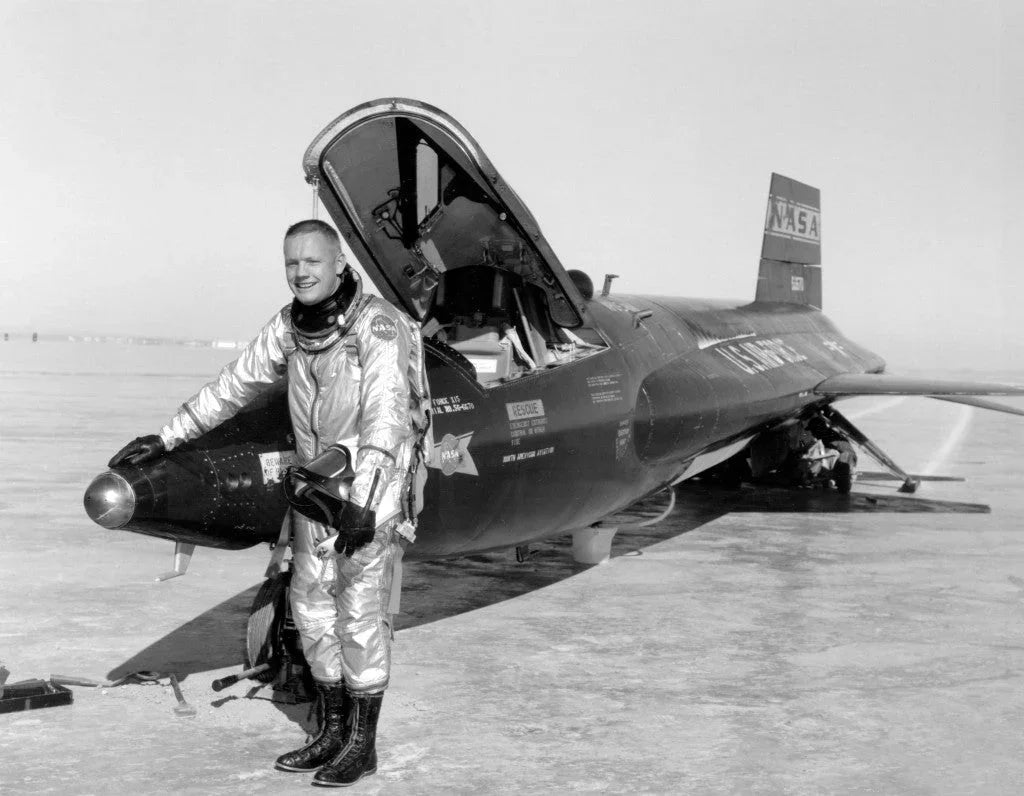The X-15 Test Program
The X-15 program started on October 5, 1954, with the first flight on June 8, 1959, when Scott Crossfield was dropped from a modified B-52 bomber and glided from 37,550 feet to the lake bed below.
This first flight was the beginning of one of the most successful test programs in history.
The last flight took place on October 24, 1968, when test pilot Bill Dana reached a speed of 5.38 Mach and an altitude of 255,000 feet.
With the rocket engine at full power and 57,000 pounds of 100 percent thrust, the whole flight lasted 84 seconds. This whole flight took a total of 11 minutes and 28 seconds.
However, the world records were set by pilot Joseph Walker who achieved a speed of 6.7 Mach (4,520 mph) on October 3, 1967, and an altitude of 354,200 feet on August 22, 2963, records which stand to this day.
The program finished after setting both the world speed and altitude records to be held by a powered, piloted airplane that still stands today!
Design

A NASA Illustration with multiple views of the design of the X-15 hypersonic aircraft.
The distinguished Langley aeronautical researcher John Becker, who had been an early advocate of the X-15 program, identified 25 specific accomplishments of the effort. These included:
- First application of hypersonic theory and wind tunnel work to an actual flight vehicle.
- First use of reaction controls for attitude control in space.
- First reusable superalloy structure capable of withstanding the temperatures and thermal gradients of hypersonic reentry.
- Development of (a servo-actuated ball) nose flow direction sensor for operation over an extreme range of dynamic pressure and a stagnation air temperature of 1,900° F (for accurate measurement of air speed and flow angle at supersonic and hypersonic speeds).
- Development of the first practical full pressure suit for pilot protection in space.
- Development of inertial flight data systems capable of functioning in a high dynamic pressure and space environment.
- Discovery that hypersonic boundary layer flow is turbulent and not laminar.
- Discovery that turbulent heating rates are significantly lower than had been predicted by theory.
- First direct measurement of hypersonic aircraft skin friction and discovery that skin friction is lower than had been predicted.
- Discovery of hot spots generated by surface irregularities. (These last four discoveries including the Space Shuttle.)
- Discovery of methods to correlate base drag measurements with tunnel test results so as to correct wind tunnel data (and thereby improve design criteria for future air- and spacecraft).
- Demonstration of a pilot’s ability to control a rocket boosted aerospace vehicle through atmospheric exit.
- Successful transition from aerodynamic controls to reaction controls and back again.
- First application of energy-management techniques (for the positioning of the vehicle for all future reusable launch vehicles following their reentry from space.)
- Use of the three X-15 aircraft as testbeds to carry a wide variety of experimental packages.

Image of the typical research paths flown by the X-15 pilots.
These experiments - 28 of them - ranged from astronomy to micrometeorite collection. They included tests of horizon definition and proposed insulation that bore fruit in the navigation equipment and thermal protection used on the Saturn launch vehicles in the Apollo program, which dispatched 12 astronauts to the moon and back.
Among the 12 astronauts was Neil Armstrong, the first human to step on the moon's surface and a former X-15 pilot.
X-15 Pilots
(In order by dates of first flights, includes number of flights)
- A. Scott Crossfield, North American Aviation, 14
- Joseph A. Walker, NASA, 25
- Robert M. White, United States Air Force (USAF), 16
- Forrest S. Petersen, United States Navy, 5
- John B. McKay, NASA, 29
- Robert A. Rushworth, USAF, 34
- Neil A. Armstrong, NASA, 7
- Joe H. Engle, USAF, 16
- Milton O. Thompson, NASA, 14
- William J. Knight, USAF, 16
- William H. Dana, NASA, 16
- Michael J. Adams, USAF, 7
- Total Number of Flights: 199
The X-15 had its share of emergency landings and accidents, but only two produced serious injuries or death.
On Nov. 9, 1962, Jack McKay experienced an engine failure and landed at Mud Lake, Nevada.
The landing gear collapsed, flipping him and the aircraft on its back.
Although he recovered from his injuries sufficiently to fly again, he eventually had to retire because of them.
On Nov. 15, 1967, on Michael Adams seventh flight, he entered a spin from which he was able to recover but could not bring it out of an inverted dive because of a technical problem with the adaptive flight control system.
He died in the resultant crash of the X-15 number three.
The X-15

Cutaway drawing of the North American X-15 by NASA
I hope you enjoyed this trip through some of the history of aviation. If you enjoyed this trip, and are new to this newsletter, sign up to receive your own weekly newsletter here: Subscribe here:
Until next time, keep your eyes safe and focused on what's ahead of you, Hersch!







Leave a comment
This site is protected by hCaptcha and the hCaptcha Privacy Policy and Terms of Service apply.